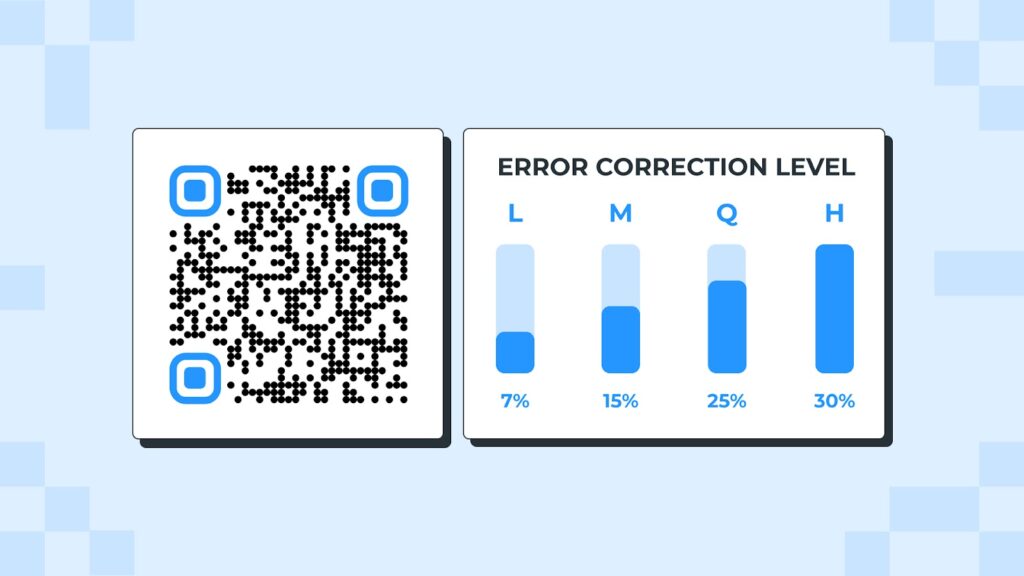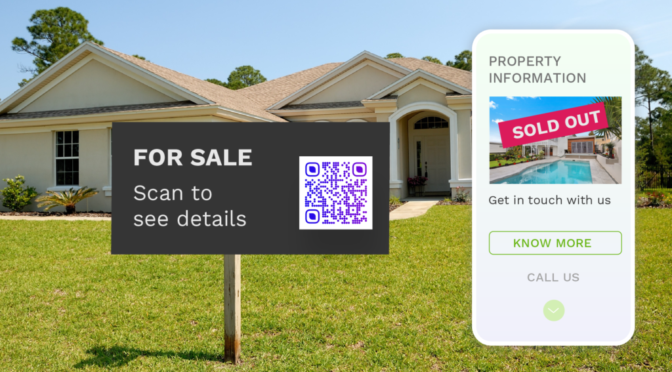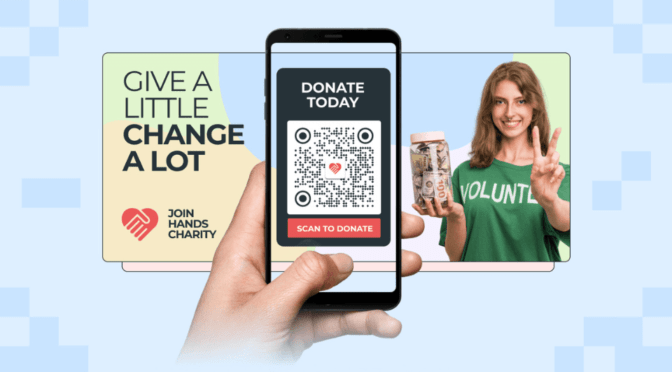💻 Key takeaways:
1. High-resolution QR Codes retain clarity and detail even when resized or printed at large sizes. This ensures optimal scannability on diverse marketing materials, from billboards and posters to brochures and packaging.
2. Choose vector formats like SVG or EPS for your high-resolution QR Codes. These formats are lossless, meaning they maintain quality regardless of size, making them ideal for printing and scaling.
3. Ensure clear and high-resolution visuals in your QR Code design. Maintain a minimum size suitable for scanning on various devices. Test your code thoroughly at different sizes and distances before deployment.
QR Codes are versatile tools that go on diverse marketing materials. From out-of-home (OOH) advertising to magazines and direct mail, they’re a revenue-oriented addition to marketing collaterals.
But, every marketing material is of a different size. Billboards and digital screens are larger compared to magazines and brochures.
The size variation leads to a persistent issue for designers and illustrators: If they use QR Code images, they must constantly resize them for different marketing materials.
Resizing the QR Code image to either large, small, or custom size requirements could render it blurry and less scannable.
But, a simple solution is to use high-resolution QR Codes. Here’s why:
– High-resolution QR Codes do not blur or pixelate when resized
– They’re ideal to use across print and digital advertising
Read on to learn more about high-resolution QR Codes, how to choose the right formats for your use case, and some best practices to remember before your QR Code goes live!
Table of contents
- What is a high-resolution QR Code?
- Download your high-resolution QR Code in a suitable format
1. Vector format
2. Raster format - Best practices before downloading your high-resolution QR Code
- Why choose Uniqode’s high-resolution QR Code generator
- Frequently asked questions
What is a high-resolution QR Code?

In simple terms, a high-resolution QR Code retains its clarity and quality when resized. It’s a high-resolution image that goes on print and digital marketing materials.
You can lead a person who scans the QR Code to a website, landing page, or any digital media you choose to redirect them to.
For example, here’s a high-resolution QR Code image used in two ways.

The first is a billboard by TIME magazine, which includes a designer QR Code that’s resized. However, it renders the QR Code redundant as it cannot be scanned.
The second one is a campaign by Hackerone. This includes a high-resolution QR Code that’s resized as per requirement. This is scannable from afar and isn’t blurred.
The audience is more likely to engage with the second QR Code.
That’s how much of a customer-centric impact a high-resolution QR Code can have on your marketing campaign.
With a high-resolution QR Code, you can resize, customize and attach them to digital and print media with zero compromises on quality or clarity.
Download your high-resolution QR Code in a suitable format
High-resolution QR Codes come in vector and raster formats.
To download a high-resolution QR Code, you need a QR Code creator that allows you to customize the size and choose the required file formats.
Uniqode’s QR Code maker does exactly that and more to help you generate high-resolution QR Codes.
Here’s a simple breakdown of the QR Code formats and how to choose one that best fits your campaign:
Vector formats
Vector QR Codes use paths rather than pixels. Pixels are seen in regular QR Code images. This advantage of using paths allows vector QR Codes to be scalable in size, without losing resolution. You can also save them under different file extensions. The common ones include:
1. EPS format

The EPS format for high-resolution QR Codes is recommended for offline print purposes. Designers and marketing professionals can use this format for printing high-resolution QR Codes on large surfaces such as banners, traditional billboards, and posters.
Here’s the advantage: An EPS QR Code is resolution independent. Designers and illustrators can freely resize the QR Code based on the requirements for large print media.
Consider a billboard with a QR Code. High-resolution QR Codes are a must in this case, as they ensure scannability from a larger distance.
2. SVG format

This format is a type of vector QR Code that is recommended for digital purposes. This high-resolution QR Code can be the choice for designers and illustrators who work with media for bigger digital screens.
Here’s a case in point: The movie Andromeda showcased a QR Code on cinema screens that encouraged viewers to scan. This example represents the use of SVG QR Codes for bigger screens. In this case, using a high resolution QR Code generator ensured that neither the scannability nor the image resolution is compromised.

Raster formats
Raster formats are images with pixels rather than paths, unlike vector QR Codes.
Typically, each raster QR Code image has a set number of pixels. Since this format uses pixels, resizing them on a larger scale leads to the distortion of the image, rendering the QR Code blurry.
Hence, a high-resolution QR Code in raster formats is more suited for smaller to medium-sized print media. Of these, there are two formats:
1. PNG format
A PNG QR Code is a type of image QR Code that is resolution-dependent. Enlarging a PNG QR Code over larger surfaces just stretches the pixels in the image, making it look less sharp.
These formats work best with smaller surfaces and hence are popular with graphic designers and illustrators. These high-resolution QR Codes are ideal for use in business cards, digital images, or marketing materials such as magazines.
For instance, consider Vogue Singapore’s Autumn 2020 launch issue. Since this print magazine is design and illustration-heavy, adding a small or transparent QR Code blends in with the design. The magazine redirected its readers to various AR and VR interactive features.

PNG high-resolution QR Codes are best fit for campaigns that need smaller-sized QR Codes.
2. JPG format
A high-resolution QR Code downloaded in JPG format works best for proximity use cases where the consumer need not scan the code from afar.
Similar to the PNG format, this is also an image that is resolution dependent, and hence you cannot rescale them for larger use cases.
For instance, JPG high-resolution QR Codes work best for use cases such as QR Code menus.
Restaurants across the globe have adopted QR Code menus, and this cafe in the US is an example. West Egg Cafe in Atlanta uses high-resolution QR Code images for their menus.

Best practices to follow before downloading your high-resolution QR Code
A High-resolution QR Code solves the issue of resizing and allow you to freely modify the QR Code to your custom requirements.
However, here are some best practices before downloading your QR Code to ensure its performance stays unaffected:
1. Check resolution requirements

Resolution plays a key role, be it in larger or smaller QR Code campaigns. High-resolution QR Codes maintain sharpness and clarity even when printed or displayed at larger sizes, ensuring readability and scanability.
Even after you’ve created a high-resolution QR Code, the next question is the custom resizing based on marketing materials.
Based on the marketing channel that you use, here are two things to keep in mind in terms of resolution:
- Ensure the QR Code is above minimal size – Whether it’s for a traditional billboard, a digital, or a TV advertisement, ensure that you use a high-resolution QR Code that’s above the minimum required size of 2×2 cm.
- Determine the size of the QR Code in relation to scanning distance– The general rule of thumb for an ideal QR Code size is a 10:1 distance-size ratio. This means that the QR Code should be 1/10th of the distance which the end users scan it from.
For instance, consider a billboard. Its typical scanning distance is 750-1500cm, and hence, the optimal QR Code size would be 75-150cm.
Keep in mind: QR Code sizes differ based on the marketing materials. For more, read our guide on common use cases and how to size QR Codes accordingly.
2. Do a trial scan before printing

When printed, high-resolution QR Codes retain their quality and legibility, even on high-gloss or textured surfaces, ensuring accurate scanning. However, doing a trial scan before printing them is always essential.
The cost associated with larger or medium-sized print advertisements such as billboards is huge as it is. Thus, ensuring that there’s no issue with the destination URL is crucial. A minor issue such as the wrong URL can affect brand reputation.
3. Customize QR Codes

QR Codes need not just be black and white, especially for larger campaigns. The better the eye-catching elements of a QR Code, the higher the chances of the audience scanning it.
Customized QR Codes do exactly that by aligning brand image and features with the end-users’ attention.
For instance, you can add a color theme and logo to your high-resolution QR Code to better match your brand image. You can also customize it further by adding a CTA and a background.
High-resolution QR Codes can contain intricate details and fine lines without sacrificing scannability, allowing for complex designs or logos to be incorporated. Ultimately, our recommendation is to ensure that the high-resolution QR Code stands out and is scannable to gather analytics.
4. Set error correction levels

QR Codes on marketing materials such as billboards or magazines can often get damaged due to wear and tear. But, this need not mean that they require a reprint or that their scannability is lost.
High-resolution QR Codes can include the latest error correction algorithms, ensuring reliability and resilience against damage or distortion. Set high levels of QR Code error correction to ensure that your high-resolution QR Codes are scannable and work through frequent usage. You can customize a QR Code error correction level on the Uniqode dashboard.
Based on the durability of the marketing material and the environment it is deployed in, select a level of QR Code error correction that best sustains any damage it may go through.
Get started with Uniqode’s high-resolution QR Code generator
With Uniqode, you can make QR Codes in different formats and access custom resizing. You can create, edit, and manage all your QR Codes with ease.
Our high-resolution QR Code generator is data compliant, safe, and has an intuitive dashboard to track QR Code performance metrics. What does that mean?
You get compliant end-user data when people scan and gather analytics on how well your QR Code is performing. In addition, you can generate QR Codes in bulk, integrate with other software like a CRM tool and automate campaigns.
If you’re looking to create a high-resolution QR Code, here’s your cue to sign up and try it out with a 14-day free trial.

Frequently asked questions
1. How to make a high-resolution QR Code?
You can make a high-resolution QR Code in 4 easy steps:
1. Log in to Uniqode’s dashboard and select ‘+Create’.
2. Choose your QR Code campaign type and input details accordingly.
3. Customize your QR Code and click on ‘Next’.
4. Download your QR Code in a high-resolution format like EPS or SVG
2. How do I increase the resolution of a QR Code?
While one cannot increase the resolution of a QR Code image, it is possible to create high resolution QR Codes. Create a QR Code in SVG or EPS format as they are resolution independent. High resolution QR Codes can be resized and are flexible and scalable with no loss of quality.
3. How do I resize a QR Code without losing quality?
A high resolution QR Code can be resized without losing quality by choosing the SVG or EPS format. These QR Codes are resolution independent and can be resized to fit any marketing material without loss of quality.
4. What is the best resolution for QR code?
For digital QR Codes, the best resolution recommended is 240 by 240 pixels or 6.3×6.3cm. For QR Codes on print materials, 38×38 pixels or 2cmx2cm is the best resolution to ensure scannability.
5. How do I fix a blurry QR code?
To fix blurry QR Codes, its best to download your QR Code in a high resolution format. If you’re sharing QR Codes on digital or print, select a high resolution format such as EPS or SVG to download and avoid blurry QR Codes.
Ektha is a QR code expert with years of research and analysis into the evolution of QR codes. Having written over 70 in-depth articles on QR technology, she has developed a comprehensive understanding of how QR codes are transforming industries. Her insights, including The State of QR Report, have been featured in leading publications. With a passion for simplifying complex topics and providing actionable strategies, Ektha helps businesses leverage QR codes to enhance their ‘phygital’ connections.













